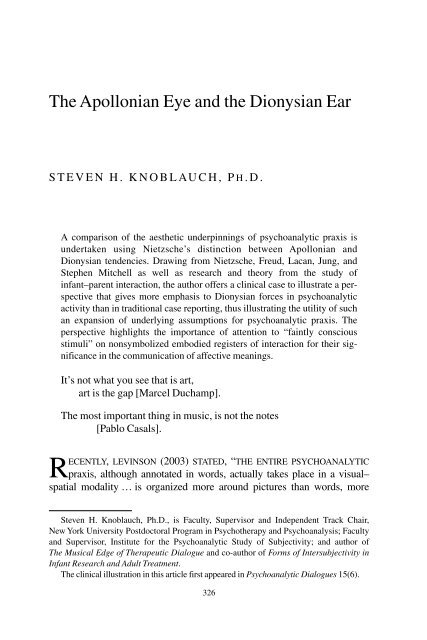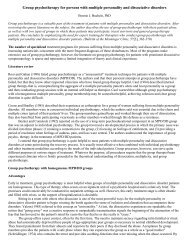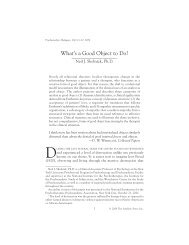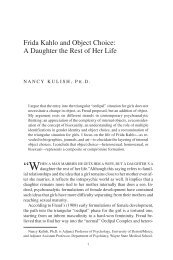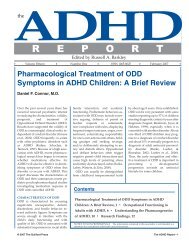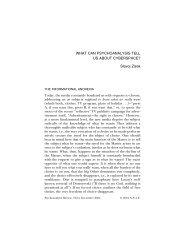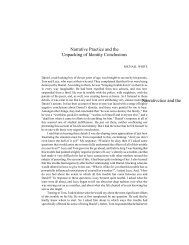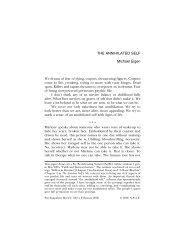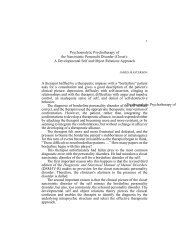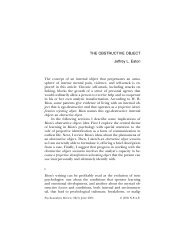The Apollonian Eye and the Dionysian Ear - PsyBC
The Apollonian Eye and the Dionysian Ear - PsyBC
The Apollonian Eye and the Dionysian Ear - PsyBC
You also want an ePaper? Increase the reach of your titles
YUMPU automatically turns print PDFs into web optimized ePapers that Google loves.
<strong>The</strong> <strong>Apollonian</strong> <strong>Eye</strong> <strong>and</strong> <strong>the</strong> <strong>Dionysian</strong> <strong>Ear</strong><br />
S T E V E N H . K N O B L AU C H , P H . D .<br />
A comparison of <strong>the</strong> aes<strong>the</strong>tic underpinnings of psychoanalytic praxis is<br />
undertaken using Nietzsche’s distinction between <strong>Apollonian</strong> <strong>and</strong><br />
<strong>Dionysian</strong> tendencies. Drawing from Nietzsche, Freud, Lacan, Jung, <strong>and</strong><br />
Stephen Mitchell as well as research <strong>and</strong> <strong>the</strong>ory from <strong>the</strong> study of<br />
infant–parent interaction, <strong>the</strong> author offers a clinical case to illustrate a perspective<br />
that gives more emphasis to <strong>Dionysian</strong> forces in psychoanalytic<br />
activity than in traditional case reporting, thus illustrating <strong>the</strong> utility of such<br />
an expansion of underlying assumptions for psychoanalytic praxis. <strong>The</strong><br />
perspective highlights <strong>the</strong> importance of attention to “faintly conscious<br />
stimuli” on nonsymbolized embodied registers of interaction for <strong>the</strong>ir significance<br />
in <strong>the</strong> communication of affective meanings.<br />
It’s not what you see that is art,<br />
art is <strong>the</strong> gap [Marcel Duchamp].<br />
<strong>The</strong> most important thing in music, is not <strong>the</strong> notes<br />
[Pablo Casals].<br />
RECENTLY, LEVINSON (2003) STATED, “THE ENTIRE PSYCHOANALYTIC<br />
praxis, although annotated in words, actually takes place in a visual–<br />
spatial modality … is organized more around pictures than words, more<br />
Steven H. Knoblauch, Ph.D., is Faculty, Supervisor <strong>and</strong> Independent Track Chair,<br />
New York University Postdoctoral Program in Psycho<strong>the</strong>rapy <strong>and</strong> Psychoanalysis; Faculty<br />
<strong>and</strong> Supervisor, Institute for <strong>the</strong> Psychoanalytic Study of Subjectivity; <strong>and</strong> author of<br />
<strong>The</strong> Musical Edge of <strong>The</strong>rapeutic Dialogue <strong>and</strong> co-author of Forms of Intersubjectivity in<br />
Infant Research <strong>and</strong> Adult Treatment.<br />
<strong>The</strong> clinical illustration in this article first appeared in Psychoanalytic Dialogues 15(6).<br />
326
THE APOLLONIAN EYE AND THE DIONYSIAN EAR 327<br />
around interactions than explanations.” (pp. 233–234). Levinson’s “logical<br />
inversion,” as he calls it, of <strong>the</strong> psychoanalytic method represents an innovative<br />
extension in thinking about <strong>the</strong> place of symbolization in <strong>the</strong> analyst’s<br />
subjective activity. His contribution is to recognize how imagistically based<br />
are analytic constructions <strong>and</strong> to remind us that words are not <strong>the</strong> product of<br />
this symbolizing process so much as normatively shared building blocks<br />
for representing interactive scenes or creative acts of deconstruction serving<br />
as <strong>the</strong> basis for much, if not all, psychodynamic formulations, even when<br />
<strong>the</strong>y are schematic representations of intrapsychic dynamics as, for example,<br />
in Freud’s early drawing depicting different agencies of mind.<br />
In this article I suggest that <strong>the</strong> <strong>Apollonian</strong> aes<strong>the</strong>tic has guided much of<br />
systematic modeling implicit in psychoanalytic <strong>the</strong>orizing including<br />
Levinson’s most recent observations. Fur<strong>the</strong>rmore, I suggest that <strong>the</strong> expansion<br />
of forms of analytic attention currently emphasized in psychoanalytic<br />
thought can be fur<strong>the</strong>r elaborated through a consideration of <strong>the</strong> <strong>Dionysian</strong><br />
aes<strong>the</strong>tic that underlies this emergent expansion of practice.<br />
Demonstrating <strong>the</strong> origins of <strong>the</strong> two aforementioned aes<strong>the</strong>tics in artistic<br />
expression, Nietzsche (1995) explained that <strong>the</strong> <strong>Apollonian</strong> tendency favored<br />
sculpture <strong>and</strong> dreams: for, “In our dreams we delight in <strong>the</strong> immediate apprehension<br />
of form … ” (p. 2). Clearly, it was Freud’s recognition of what is<br />
formed in dreams, as well as in o<strong>the</strong>r nonreflective activity including daydreams,<br />
slips of tongue, <strong>and</strong> associations, that served as <strong>the</strong> material for subsequent<br />
reflection in psychoanalytic praxis. Freud’s recognition of a latent set of<br />
meanings connected in complex ways to <strong>the</strong> manifest formations emergent in<br />
dreams <strong>and</strong> o<strong>the</strong>r imagistic productions became <strong>the</strong> central fulcrum for analytic<br />
work <strong>and</strong> is still central in contemporary psychoanalytic approaches,<br />
whe<strong>the</strong>r <strong>the</strong>se latent meanings be constructed through <strong>the</strong> lens of an object<br />
relations, interpersonal, self psychological, relational, or o<strong>the</strong>r perspective.<br />
On <strong>the</strong> o<strong>the</strong>r h<strong>and</strong>, Nietzsche (1995) also traced <strong>the</strong> Greek origins of a<br />
<strong>Dionysian</strong> aes<strong>the</strong>tic that favored <strong>the</strong> “non-plastic … art of music.” (p. 1),<br />
awakening emotions, “which, as <strong>the</strong>y intensify, cause <strong>the</strong> subjective [or<br />
principium individuationis of which Nietzsche claimed Apollo was <strong>the</strong><br />
image] to vanish into complete self-forgetfulness” (p. 1). (Freud, by <strong>the</strong><br />
way, did not favor music <strong>and</strong> believed he had no ear for <strong>the</strong> stuff.) Under<br />
<strong>the</strong> <strong>Dionysian</strong> tendency “one feels himself not only united, reconciled,<br />
blended with his neighbor, but as one with him; [<strong>the</strong> opposite of principium<br />
individuationis] he feels <strong>the</strong> veil of Maya had been torn aside <strong>and</strong> were now<br />
merely fluttering in tatters before <strong>the</strong> mysterious Primordial Unity”<br />
(Nietzsche, 1995, p. 2). In o<strong>the</strong>r words, <strong>the</strong> <strong>Dionysian</strong> sees form as an
328 STEVEN H. KNOBLAUCH<br />
illusion that separates things <strong>and</strong> individuals <strong>and</strong> hides <strong>the</strong> rhythmic<br />
movement that connects <strong>and</strong> reconnects all things. In many ways, <strong>the</strong><br />
<strong>Apollonian</strong> <strong>and</strong> <strong>Dionysian</strong> tendencies parallel Freud’s idea of Thanatos <strong>and</strong><br />
Eros where Thanatos is <strong>the</strong> deadening of experience <strong>and</strong> Eros a force<br />
bringing vitality. Interestingly Lacan (1977) in his reading of Freud,<br />
described how <strong>the</strong> word as “symbol manifests in itself first as <strong>the</strong> murder of<br />
<strong>the</strong> thing” (p. 104). Here we see words as a force of Thanatos. For Lacan,<br />
<strong>the</strong> form giving word captures <strong>and</strong> memorializes, deadens as it symbolizes.<br />
Freud’s take on <strong>the</strong> word as symbol was different. Freud saw meaning, a<br />
new source of aliveness, coming from connectedness as when a “thing” is<br />
connected in consciousness with <strong>the</strong> “word” to bring about symbolization.<br />
So for Freud symbolization is an erotic act of connection, bringing life,<br />
whereas for Lacan, symbolization is a thanatic act of collapsing space for<br />
growth <strong>and</strong> movement, bringing death, two clearly different readings of <strong>the</strong><br />
<strong>Apollonian</strong>. Carl Jung <strong>and</strong> Stephen Mitchell read <strong>the</strong> implications of<br />
Nietzsche’s contribution for psychoanalytic practice differently.<br />
Whereas I have suggested that Nietzsche’s <strong>the</strong>sis can be used to reconsider<br />
how Freud <strong>and</strong> Lacan understood meaning to be constructed <strong>and</strong> registered<br />
symbolically, Jung used Nietzsche’s contributions to contribute a<br />
model of personality types for distinguishing different styles of subjectivity<br />
for organizing meaning. Jung saw <strong>the</strong> <strong>Apollonian</strong> capable of an inner perception<br />
of beauty, as a psychological introvert producing dream images to<br />
organize <strong>the</strong> world (Jung, 1923, pp. 170–183). In a certain sense, any practicing<br />
psychoanalyst is an Appollonian in Jung’s terms, as we all need to<br />
subjectively produce internal images to organize a sense of our selves <strong>and</strong><br />
“<strong>the</strong> world” to which we relate. (We could easily extend this generalization<br />
to all beings capable of reflective functioning.) On <strong>the</strong> o<strong>the</strong>r h<strong>and</strong>, <strong>the</strong><br />
<strong>Dionysian</strong> was understood by Jung to be an extraverted personality type<br />
who, in contrast to <strong>the</strong> <strong>Apollonian</strong> (guided by dreams), is ra<strong>the</strong>r guided by<br />
an “intoxicated” contact with <strong>the</strong> world, akin to Goe<strong>the</strong>’s “diastole” or<br />
Schiller’s “world embracing.” Nietzsche reconciled <strong>the</strong>se two types with an<br />
aes<strong>the</strong>tic solution apparent to him in <strong>the</strong> development of Greek tragedy,<br />
one that Mitchell (1988) summarized for a relational perspective.<br />
As Mitchell (1988) puts it:<br />
<strong>The</strong> <strong>Apollonian</strong> builds elaborate s<strong>and</strong>castles, throwing himself into<br />
his activity as if his creations would last forever, totally oblivious to<br />
<strong>the</strong> incoming tide which will demolish his productions. … <strong>The</strong><br />
<strong>Dionysian</strong> man sees <strong>the</strong> inevitability of <strong>the</strong> leveling tide <strong>and</strong> <strong>the</strong>refore
THE APOLLONIAN EYE AND THE DIONYSIAN EAR 329<br />
builds no castles. His constant preoccupation with <strong>the</strong> ephemeral<br />
nature of his life <strong>and</strong> his creations allows him no psychic space in<br />
which to live <strong>and</strong> play … Here is someone tyrannized <strong>and</strong> depleted<br />
by reality [p. 195].<br />
(It is interesting to compare Mitchell’s notion of <strong>the</strong> <strong>Dionysian</strong> preoccupation<br />
with <strong>the</strong> ephemeral nature of phenomena as collapsing psychic space,<br />
whereas Lacan saw <strong>the</strong> <strong>Apollonian</strong> process of giving form to experience<br />
with <strong>the</strong> word as having a similar deadening <strong>and</strong> constricting impact on<br />
experience.) Mitchell describes Nietzsche’s tragic man as “aware of <strong>the</strong><br />
tide <strong>and</strong> <strong>the</strong> transitory nature of his productions, yet building his s<strong>and</strong>castles<br />
never<strong>the</strong>less … <strong>The</strong> tragicomic play in which our third man builds,<br />
Nietzsche suggests, is <strong>the</strong> richest form of life, generating <strong>the</strong> deepest meaning<br />
from <strong>the</strong> dialectical interplay of illusion <strong>and</strong> reality” (p. 195).<br />
But, in disagreement with Mitchell’s later reading, Jung rejects<br />
Nietzsche’s tragic man aes<strong>the</strong>tic solution <strong>and</strong> offers a different source of<br />
reconciliation. Jung (1923) states that “<strong>the</strong> aes<strong>the</strong>tic st<strong>and</strong>point always<br />
falls, i.e. it holds itself aloof from <strong>the</strong> problem” (p. 178). Jung’s approach<br />
is to add <strong>the</strong> recognition of intuitive <strong>and</strong> sensation types of personality <strong>and</strong><br />
contrast <strong>the</strong>se with <strong>the</strong> thinking (introvert) <strong>and</strong> feeling (extravert) types in<br />
<strong>the</strong> following way: “Both <strong>the</strong>se types [<strong>the</strong> intuitive <strong>and</strong> <strong>the</strong> sensation<br />
types] have <strong>the</strong> mechanisms of introversion <strong>and</strong> extroversion in common<br />
with <strong>the</strong> rational types but <strong>the</strong>y do not—like <strong>the</strong> thinking type on <strong>the</strong> one<br />
h<strong>and</strong>—differentiate <strong>the</strong> perception <strong>and</strong> <strong>the</strong> contemplation of <strong>the</strong> inner<br />
image into thought, nor—like <strong>the</strong> feeling type on <strong>the</strong> o<strong>the</strong>r—differentiate<br />
<strong>the</strong> affective experience of instinct <strong>and</strong> sensation into feeling” (pp. 181–182).<br />
Ra<strong>the</strong>r Jung sees <strong>the</strong>se intuitive <strong>and</strong> sensation types as adapting <strong>the</strong>mselves<br />
“by means of unconscious indications, which … [<strong>the</strong>y receive]<br />
through an especially fine <strong>and</strong> sharpened perception <strong>and</strong> interpretation of<br />
faintly conscious stimuli” (pp. 181–182). Jung’s recognition of <strong>the</strong> significance<br />
of a not yet symbolized “indication” arrived at through attention to<br />
“faintly conscious stimuli” will become critical to a fur<strong>the</strong>r consideration<br />
of Levinson’s take on <strong>the</strong> organizing processes of an analyst’s subjectivity.<br />
As part of that consideration, my reading of Jung is that his critique<br />
catches Nietzsche sliding into an <strong>Apollonian</strong> solution. Nietzsche’s tragicomic<br />
man in his courage to build s<strong>and</strong>castles in <strong>the</strong> face of an anticipated<br />
obliterating tide seems too intellectual, too dissociated from <strong>the</strong> pain of loss<br />
of form, <strong>the</strong> loss of a coherent sense of self <strong>and</strong> reliable ties to o<strong>the</strong>rs.<br />
Tragicomic man seems unable to experience <strong>the</strong> closeness of intimacy with
330 STEVEN H. KNOBLAUCH<br />
his own life’s productions or with <strong>the</strong> lives of o<strong>the</strong>rs. <strong>The</strong> price for <strong>the</strong> tragicomic<br />
acceptance of transitoriness is <strong>the</strong> cold, anes<strong>the</strong>tization, <strong>the</strong> deadening<br />
intellectualization of aloofness that Lacan recognized forms of symbolization<br />
could bring to personal experience. Tragicomic man simply retreats to a<br />
new aes<strong>the</strong>tic of form that feels like <strong>the</strong> commodification of contemporary<br />
life, where artifacts are simply temporary tools, like Ikea furniture or computers<br />
<strong>and</strong> cell phones that are destined to be obliterated by <strong>the</strong> rapid rhythms<br />
of change in life styles <strong>and</strong> technological progress; where human lives<br />
become an abstract statistic, <strong>and</strong> personal <strong>and</strong> collective violence become too<br />
easily rationalized <strong>and</strong> anes<strong>the</strong>tized (see Scarry’s <strong>The</strong> Body in Pain, 1985).<br />
But, while Nietzsche’s aes<strong>the</strong>tic solution seems to lean toward an<br />
<strong>Apollonian</strong> tendency <strong>and</strong> <strong>the</strong> pitfalls inherent in such a position, I read<br />
Jung’s solution as leaning heavily on a connection to a Primordial Unity,<br />
an absence of capacities for delineation or differentiation that Nietzsche<br />
would characterize as <strong>Dionysian</strong>. Critical to Jung’s discrimination of <strong>the</strong><br />
additional personality types of intuitive <strong>and</strong> sensation is that <strong>the</strong>y do not<br />
differentiate processes such as perception, contemplation, affective experience,<br />
or sensation from processes such as thinking or feeling. So, <strong>the</strong><br />
intuitive type does not discriminate his or her dream about a relationship<br />
from <strong>the</strong> shared experiences that construct a relational tie, <strong>and</strong> <strong>the</strong> sensation<br />
type does not discriminate an erotic sensation or an aggressive urge<br />
from a feeling of love or hate.<br />
In contrast to Jung’s view, Mitchell reconsiders <strong>the</strong> dialectical interplay<br />
of illusion <strong>and</strong> reality pointing us toward Loewald’s reminder that <strong>the</strong> word<br />
“illusion” (Loewald, 1974, p. 354) “derives from <strong>the</strong> Latin ludere, to play.<br />
Healthy narcissism reflects Nietzsche’s subtle dialectical balance between<br />
illusions <strong>and</strong> reality; illusions concerning oneself <strong>and</strong> o<strong>the</strong>rs are generated,<br />
playfully enjoyed, <strong>and</strong> relinquished in <strong>the</strong> face of disappointments”<br />
(Mitchell, 1988, p. 195). Mitchell’s version of tragic man exp<strong>and</strong>ing<br />
Nietzsche’s tragic aes<strong>the</strong>tic solution with a playful one emerging from a<br />
close reading of Loewald is interesting to consider in light of Kohut’s view<br />
of tragic man as suffering from unmet developmental needs, narcissistic<br />
injuries re-emerging in self-object dimensions of transference, that is, as<br />
needs for mirroring, idealization, <strong>and</strong> twinship. Of what relevance are <strong>the</strong>se<br />
unmet needs to analytic interaction Guided by researchers of infant–<br />
mo<strong>the</strong>r interaction, I read Kohut’s unmet developmental needs as resulting<br />
from dysjunctive rhythms of connection that are critical to <strong>the</strong> determination<br />
of whe<strong>the</strong>r <strong>the</strong> interplay between illusion <strong>and</strong> reality is constructed as<br />
playful or annihilating. This is <strong>the</strong> difference between humor <strong>and</strong> shaming.
THE APOLLONIAN EYE AND THE DIONYSIAN EAR 331<br />
Infant researchers <strong>and</strong>, more recently, analysts guided by <strong>the</strong> need for<br />
attention to registers of experience o<strong>the</strong>r than <strong>the</strong> symbolic such as gesture,<br />
tone, <strong>and</strong> rhythm have begun to describe <strong>the</strong> kind of “faintly conscious<br />
stimuli,” with which Jung explains intuition <strong>and</strong> sensation <strong>and</strong> which can<br />
be catalytic to how experience is constructed as playful or shameful.<br />
Tronick (1989) <strong>and</strong> Tronick <strong>and</strong> Cohen (1989), observing mo<strong>the</strong>r–infant<br />
dyads, <strong>and</strong> Fivaz-Depeursinge <strong>and</strong> Corboz-Warnery (1999), observing<br />
family triads, have noted ways in which <strong>the</strong> rhythmic timing of responses<br />
can construct too much, too little, or a “good enough” amount of matching<br />
in movement of pelves, heads, gazes, facial expression, voice intonations,<br />
<strong>and</strong> gestures to sustain an ongoing sense of relatedness. Tronick’s work<br />
suggests that a response within a two-second window is sustaining<br />
whereby a pause of greater duration can create <strong>the</strong> uncertainty <strong>and</strong> concomitant<br />
affective states characteristic of a rupture. At <strong>the</strong> same time,<br />
matching occurs for <strong>the</strong> most securely attached pairs only one third of <strong>the</strong><br />
time. That a securely attached pair is not matched two thirds of <strong>the</strong> time<br />
suggests something similar to Winnicott’s emphasis on <strong>the</strong> value of transitional<br />
space for growth <strong>and</strong> creativity in <strong>the</strong> interactions between mo<strong>the</strong>r<br />
<strong>and</strong> child. <strong>The</strong>refore, it may not be <strong>the</strong> Appollonian states of attunement<br />
or minattunement that are constitutive of experiences of play versus<br />
shame, so much as <strong>the</strong> <strong>Dionysian</strong> rhythms of rupture <strong>and</strong> repair that can<br />
constitute “indications” of faintly conscious stimuli out of which analysts<br />
<strong>and</strong> analys<strong>and</strong>s construct a sense of play or shame, a sense of connectedness<br />
or breakdown in relatedness to self or o<strong>the</strong>r.<br />
<strong>The</strong> research of Bucci (1997) in cognitive psychology has given us a<br />
way to underst<strong>and</strong> how <strong>the</strong> rhythms of intuitive <strong>and</strong> sensate experience<br />
might be differentiated into thought <strong>and</strong> given symbolic expression. She<br />
sees <strong>the</strong>se rhythms as occurring on subsymbolic dimensions of interaction.<br />
She explains, “<strong>The</strong> categorical function, by which <strong>the</strong> continuous gradients<br />
of perceptual experience are chunked into discrete prototypical images, is<br />
<strong>the</strong> core of <strong>the</strong> symbolizing process” (p. 142). In comparing subsymbolic<br />
with symbolic levels of cognitive processing, she explains, “<strong>The</strong>se [varieties<br />
of information processing] include representations <strong>and</strong> processes<br />
in which <strong>the</strong> elements are not discrete, organization is not categorical,<br />
processing occurs simultaneously in multiple parallel channels, high level<br />
units are not generated from discrete elements, <strong>and</strong> explicit processing<br />
rules cannot be identified” (p. 13). She <strong>the</strong>n points out, “Subsymbolic<br />
processing accommodates infinitely fine variation; this processing is<br />
not represented by st<strong>and</strong>ard metric systems or computational rules.
332 STEVEN H. KNOBLAUCH<br />
We recognize changes in <strong>the</strong> emotional states of o<strong>the</strong>rs based on perception<br />
of subtle shifts in <strong>the</strong>ir facial expression or posture, <strong>and</strong> recognize changes<br />
in our own states based on somatic or kines<strong>the</strong>tic experience” (p. 174).<br />
Subtle shifts in face, posture, tone <strong>and</strong> rhythm of vocalization, <strong>and</strong> changes<br />
in state based on somatic or kines<strong>the</strong>tic experience seem to be <strong>the</strong> indications<br />
of faintly conscious stimuli that Jung described. Fur<strong>the</strong>rmore, <strong>the</strong>se<br />
seem to be <strong>the</strong> basis for <strong>the</strong> <strong>Dionysian</strong>’ experience of being “united, reconciled,<br />
blended with his neighbor” described by Nietzsche.<br />
An <strong>Apollonian</strong> Formulaton Including a <strong>Dionysian</strong><br />
Approach to Analytic Subjectivity<br />
Analysts are currently involved in developing new ways to think <strong>and</strong> talk<br />
about harnessing Bucci’s distinctions. How do we experience <strong>the</strong> relationship<br />
between <strong>the</strong> subsymbolic <strong>and</strong> symbolic in our clinical work<br />
How can we harvest <strong>the</strong> attention afforded us by moving between <strong>the</strong> symbolization<br />
process of organizing experience imagistically, Levinson’s point<br />
(what Jung characterized as thinking <strong>and</strong> feeling types of organization), <strong>and</strong><br />
<strong>the</strong> especially fine <strong>and</strong> sharpened perception afforded by faintly conscious<br />
stimuli that Jung recognized as characteristic of intuitive <strong>and</strong> sensation types of<br />
organization How can we employ new narratives to organize <strong>the</strong> tensions<br />
<strong>and</strong> rhythms between <strong>Apollonian</strong> structures in <strong>the</strong> form of state attunements<br />
<strong>and</strong> symbolizations on <strong>the</strong> one h<strong>and</strong>, <strong>and</strong> <strong>Dionysian</strong> perturbations of process,<br />
constructive <strong>and</strong> deconstructive of state changes, on <strong>the</strong> o<strong>the</strong>r How can we<br />
sustain <strong>the</strong> space for <strong>the</strong> kind of creative play that Mitchell calls for, which<br />
does not devolve into intellectual distance <strong>and</strong> anes<strong>the</strong>tization but sustains<br />
<strong>and</strong>/or reconnects <strong>the</strong> intuitive pains <strong>and</strong> pleasures of <strong>the</strong> sensate world to <strong>the</strong><br />
thoughts <strong>and</strong> feelings of reflective analytic practice How can we practice a<br />
kind of psychoanalysis, deeply engaging our analys<strong>and</strong>s in <strong>the</strong> “gap” or<br />
space, where analytic play emerges <strong>and</strong> moments of recognition <strong>and</strong> psychic<br />
reorganization can occur around <strong>the</strong> narcissistic injuries resulting in shaming<br />
affects that Kohut so intuitively recognized<br />
An approach to <strong>the</strong>se various <strong>and</strong> related questions suggests that <strong>the</strong><br />
“logical inversion” in thinking that Levinson offers emphasizing <strong>the</strong><br />
visual can be augmented by multiple “versions” of analytic subjectivity<br />
that can also privilege acoustic <strong>and</strong> kines<strong>the</strong>tic registers of experience<br />
emerging in <strong>the</strong> rhythms of attention between <strong>the</strong> <strong>Apollonian</strong> eye <strong>and</strong> <strong>the</strong>
THE APOLLONIAN EYE AND THE DIONYSIAN EAR 333<br />
<strong>Dionysian</strong> ear. In my reading of Jung, <strong>the</strong> word is <strong>the</strong> thinking level of <strong>the</strong><br />
image, whereas <strong>the</strong> image is <strong>the</strong> intuitive level of <strong>the</strong> word. In Jung’s revision,<br />
<strong>the</strong> <strong>Dionysian</strong> aes<strong>the</strong>tic involves <strong>the</strong> sensate as well as <strong>the</strong> intuitive.<br />
This amendment to Levinson’s perspective suggests a different inversion.<br />
Jung’s amendation inverts Freud’s organization of primary <strong>and</strong> secondary<br />
process for <strong>the</strong> psychoanalytic process. According to Freud it is <strong>the</strong> impact<br />
of <strong>the</strong> shift to secondary process, “from id to ego,” that characterizes <strong>the</strong><br />
<strong>the</strong>rapeutic impact of analytic work. Ra<strong>the</strong>r, we now seem to be looking<br />
for a way to account for powerful affective shifts in both <strong>the</strong> analyst <strong>and</strong><br />
analys<strong>and</strong> that signal important mutative effects of <strong>the</strong>rapeutic interaction<br />
even before <strong>the</strong>y are recognized <strong>and</strong> symbolically articulated. We are finding<br />
that primary process itself is <strong>the</strong> level on which shifts occur <strong>and</strong> only<br />
later do we register <strong>the</strong>se intuitive <strong>and</strong> sensate shifts on a secondary<br />
process of articulated thought <strong>and</strong> feelings. In fact, LeDoux (2002) has<br />
pointed out that sound as sensation is registered in <strong>the</strong> amygdalic structure<br />
of <strong>the</strong> brain before it is processed for representation in <strong>the</strong> cortical structure<br />
of <strong>the</strong> brain. This seems to suggest a primary process ordering of sensations<br />
where previously ordering was thought not to occur because of <strong>the</strong><br />
absence of a capacity for reflective function (Fonagy et al., 2002). This<br />
sensate organization is subjectively registered intuitively at first <strong>and</strong> <strong>the</strong>n<br />
thought about <strong>and</strong> contextualized as representations of feelings. <strong>The</strong>se<br />
thoughts <strong>and</strong> feelings are <strong>the</strong>n open to a continuous process of revision as<br />
new sensations <strong>and</strong> intuitions interact with <strong>and</strong> form <strong>the</strong> basis for editing<br />
<strong>and</strong> re-editing thoughts <strong>and</strong> feelings.<br />
Taking <strong>the</strong> previous points into consideration I believe that a <strong>Dionysian</strong><br />
analytic ear includes additional roads to <strong>the</strong> unconscious beyond <strong>the</strong><br />
dream or, for that matter, <strong>the</strong> slip or association (all forms of imagistic<br />
symbols). <strong>The</strong> <strong>Dionysian</strong> ear adds to <strong>the</strong> <strong>Apollonian</strong> eye <strong>the</strong> significance<br />
of affective communications carried on nonverbal registers of tone,<br />
rhythm, <strong>and</strong> embodied gesture <strong>and</strong> sensation by <strong>the</strong> analyst as well as by<br />
<strong>the</strong> analys<strong>and</strong> for recognizing <strong>and</strong> responding to unconscious meaning.<br />
This perspective exp<strong>and</strong>s <strong>the</strong> terrain for mutative construction in psychoanalytic<br />
praxis. It picks up <strong>and</strong> extends <strong>the</strong> daunting challenge of Racker’s<br />
(1968) formulations for attention to countertransferential meanings central<br />
to <strong>the</strong> analytic process. <strong>The</strong> following narrative of a clinical interaction<br />
is offered as a way to begin to think about how to attend to <strong>and</strong><br />
<strong>the</strong>rapeutically use <strong>the</strong> rhythms between <strong>the</strong> <strong>Apollonian</strong> scene <strong>and</strong> <strong>the</strong><br />
<strong>Dionysian</strong> music that constitute a clinical interaction.
334 STEVEN H. KNOBLAUCH<br />
Denise <strong>and</strong> Me<br />
As Denise flopped herself into <strong>the</strong> chair in front of me, her chest rose<br />
filling with air, as much as she could take in. <strong>The</strong>n when fully engorged, she<br />
suddenly <strong>and</strong> swiftly released <strong>the</strong> gas, with a deep grunt, … no growl. <strong>The</strong><br />
trumpeter Rex Stewart would similarly punctuate <strong>the</strong> plaintive soundscape<br />
of an Ellington depression era dirge. It was a cold damp January morning,<br />
dark <strong>and</strong> lonely with cloud cover obscuring <strong>the</strong> few hours of sunlight <strong>and</strong><br />
relative warmth that we are sometimes allowed during <strong>the</strong>se short days of<br />
deep winter. Often, <strong>and</strong> particularly recently, Denise had begun sessions<br />
with a similar intake <strong>and</strong> outflow of air, but <strong>the</strong> quality of her body resonance,<br />
<strong>the</strong> complex interaction of abdominal muscles, throat constriction,<br />
<strong>and</strong> facial display had usually constructed a moan of despair. When Ornette<br />
Coleman’s alto saxophone would moan similarly in <strong>the</strong> midst of his free<br />
form jazz solos of <strong>the</strong> 1960s, I would experience a visceral resonance in <strong>the</strong><br />
back of my head, gut, <strong>and</strong> spine, a kind of internal downward spiral toward<br />
bottomlessness. Interestingly, I had never attended to Denise’s moans with<br />
analytic curiosity until this morning. But now, I was impacted noticeably<br />
by this shift to a grunt. I was startled <strong>and</strong> moved in <strong>the</strong> way that I had been<br />
by Coleman’s saxophone sounds. Denise was clearly different <strong>and</strong> her gesture<br />
cut a definite opening, a shift in my attention to her body <strong>and</strong> my body<br />
<strong>and</strong> <strong>the</strong> meanings that were being constructed kines<strong>the</strong>tically.<br />
My body Well, before I could even begin to recognize <strong>the</strong> difference<br />
between now <strong>and</strong> <strong>the</strong>n, or maybe, as <strong>the</strong> register in which recognition was<br />
first taking shape this morning, I found my gut swept with an indescribable<br />
sense that I can only call a soft sadness, a movement in muscles <strong>and</strong> hormones<br />
toward tears. But I did not begin to cry. Ra<strong>the</strong>r I too took in a deep<br />
gutful of air. I sensed how it seemed to regulate my sadness, slow down <strong>the</strong><br />
muscular constrictions <strong>and</strong> increasing skin temperature that accompanies<br />
<strong>the</strong> onset of tears. When I had filled to capacity, I released <strong>the</strong> breath, but<br />
with a different resonance, one of a deep quiet sound that came from <strong>the</strong><br />
chest area <strong>and</strong> was somewhere between a moan <strong>and</strong> a sigh. Here our sound<br />
shapes briefly filled a vast area of affective space, a space made possible (at<br />
this point out of our awarenesses) for something new to begin to emerge.<br />
We had co-constructed a pause in time, but one that immediately seemed to<br />
plummet in space as a parachutist out of a plane.<br />
<strong>The</strong>n, just as rapidly, our eyes briefly met. We exchanged brief nervous<br />
smiles. But <strong>the</strong> tension in <strong>the</strong> muscles of our faces clearly suggested this
THE APOLLONIAN EYE AND THE DIONYSIAN EAR 335<br />
was not fun. I could feel it in my response <strong>and</strong> see it in hers. Now <strong>the</strong><br />
space was closing, as <strong>the</strong> time shifted. <strong>The</strong> rhythms of our “eye dialogue”<br />
here were quick <strong>and</strong> nervous, starting <strong>and</strong> stopping like <strong>the</strong> twists <strong>and</strong><br />
turns that Bartok would comm<strong>and</strong> in his compositions, or Cecil Taylor<br />
would explode in his piano improvisations. <strong>The</strong>se syncopations, combined<br />
with our earlier sound shapes, constructed feelings of uncertainty<br />
<strong>and</strong> hypervigilance.<br />
Denise, often depleted <strong>and</strong> hopeless in <strong>the</strong>se states of uncertainty <strong>and</strong><br />
hypervigilance, would speak of her sense of failure <strong>and</strong> inability to feel as if<br />
she were measuring up to anything in her professional growth <strong>and</strong> personal<br />
life. She could find no satisfaction, no vitality in anything, not in her relations<br />
with her colleagues, not in her accomplishments, not in her intimate<br />
life. Nothing mattered. And yet, she could see how o<strong>the</strong>rs would tell her that<br />
she was performing effectively in her job, or that sex was satisfying <strong>and</strong> she<br />
<strong>and</strong> her lover were getting along well <strong>and</strong> fighting with more fairness as<br />
compared to earlier in <strong>the</strong>ir relationship. But no, nothing was good enough.<br />
I noted that Denise seemed hopeless as before, but now ra<strong>the</strong>r than<br />
depleted, as we began to speak, her tone was streng<strong>the</strong>ning <strong>and</strong> her rhythmic<br />
forward pressing flow, felt full with anger, a different affective texture<br />
for our context. Was hopelessness shifting to hope on some unformulated<br />
level of experience (Stern, 1997) I couldn’t tell at this point. So, as an<br />
attentive <strong>and</strong> responsible analyst, I wondered about her satisfaction with<br />
me <strong>and</strong> <strong>the</strong> treatment, her inability to find anything good enough in what<br />
we were doing, in how responsive or not I had been—was being to her.<br />
I noted <strong>the</strong> parallel meanings to her life descriptions <strong>and</strong> our work, our<br />
relationship. She replied, slightly shifting to sadness but <strong>the</strong>n regaining <strong>the</strong><br />
forward movement of her anger that, yes, she was unhappy with what we<br />
were doing, or maybe not doing. <strong>The</strong>n, ambivalently she began to shift<br />
again. Yes we had been making some progress. <strong>The</strong>re were those sessions<br />
in which we seemed to get very close <strong>and</strong> deep, in which she felt maybe for<br />
a brief moment or two, I was getting her, that she was feeling gotten. We<br />
had explored <strong>the</strong>se moments when <strong>the</strong>y occurred earlier <strong>and</strong> found <strong>the</strong>m to<br />
be shot through with erotic <strong>and</strong> destructive feelings constructing a kind of<br />
mutual devouring, mutually engorging emotional experience of each o<strong>the</strong>r.<br />
As part of this experience, Denise noted that our week of sessions seemed<br />
to have a rhythm marked by a dissociated, devitalizing start that <strong>the</strong>n<br />
moved toward a last session of <strong>the</strong> week climax, fraught with complex<br />
somatic <strong>and</strong> semantic encounters, stimulating, if not overstimulating, but
336 STEVEN H. KNOBLAUCH<br />
never enough, only to be drained of feeling <strong>and</strong> meaning into some dissociated<br />
space again by <strong>the</strong> beginning of <strong>the</strong> next week.<br />
I had wondered with her in <strong>the</strong> past about how much she was experiencing<br />
me transferentially as some version or versions of her fa<strong>the</strong>r, to whom<br />
she had been very close <strong>and</strong> whose death had only exponentially potentiated<br />
her eating disorder <strong>and</strong> self-mutilating, which took her through a<br />
series of hospitalizations. Maybe in <strong>the</strong> weekly rhythm, we were re-enacting<br />
<strong>the</strong> loss of her fa<strong>the</strong>r resonated by <strong>the</strong> death of my affective responsiveness<br />
to her, as recreated in <strong>the</strong> unfolding affective patterning, consisting of <strong>the</strong><br />
unbearable sense of her inability to continue to vitalize him or me for<br />
which she ei<strong>the</strong>r punished herself as previously recreated in her starving<br />
<strong>and</strong> bleeding or dissociated.<br />
While her treatments had been a path back to relative satisfaction <strong>and</strong><br />
relatedness as she pursued a somewhat successful athletic career <strong>and</strong> <strong>the</strong>n<br />
higher education for <strong>the</strong> current professional activity in which she was<br />
clearly excelling <strong>and</strong> developing status <strong>and</strong> recognition, nothing had ever<br />
been enough. She could never hold onto, in fact, even ever feel, a sense of<br />
fulfillment, of having enough. It was never enough. Nothing could ever be<br />
enough. We both sat in <strong>the</strong> silence of <strong>the</strong> long pause of despair that this<br />
emptiness, this absence of presence had created between <strong>and</strong> within us.<br />
Again, we were constructing, though with significant pain, a space exp<strong>and</strong>ing<br />
time warp, an opening for some new melody or syncopation to come<br />
forth <strong>and</strong> begin to constitute a new meaning between us.<br />
Suddenly it occurred to me that ei<strong>the</strong>r I had never asked about or had dissociated<br />
<strong>the</strong> time in her development when her eating disorder <strong>and</strong> selfmutilation<br />
had begun. For some reason, we had always focused on <strong>the</strong><br />
difficulty she had accepting <strong>the</strong> death of her fa<strong>the</strong>r <strong>and</strong> never attempted to<br />
wonder about <strong>the</strong> fact that her difficulties had begun much earlier in life, as I<br />
now began to remember. My question was tentative, but clear, open to possibilities<br />
for new meaning. Denise responded to my query about this with a<br />
shift in body, rhythm, <strong>and</strong> tone. Her face <strong>and</strong> posture, relaxed. Her tone<br />
shifted from <strong>the</strong> punishing whine of adolescent anger to a lower register of<br />
sophisticated curiosity <strong>and</strong> collaboration. She began to recall how close she<br />
had been with Dad as a child. In fact, she had almost been his little boy.<br />
<strong>The</strong>y had done so much athletically toge<strong>the</strong>r. She would do things with him<br />
like mountain climbing <strong>and</strong> so she became her fa<strong>the</strong>r’s number one companion<br />
in <strong>the</strong>se activities with which <strong>the</strong>y both filled <strong>the</strong>mselves as much as<br />
possible. But, now she remembered. It was when she began to grow breasts<br />
<strong>and</strong> her body shifted from that hermaphroditic phase that can be achieved in
THE APOLLONIAN EYE AND THE DIONYSIAN EAR 337<br />
prepuberty but rarely sustained with <strong>the</strong> onset of menses that she began to<br />
despair <strong>and</strong> self-destruct. In fact, I wondered whe<strong>the</strong>r her enacted symptoms<br />
were not a crying out into <strong>the</strong> world by <strong>the</strong> “boy” companion she had been<br />
to her fa<strong>the</strong>r <strong>and</strong> longed to be forever, of that young boy’s sense of annihilation.<br />
That self version of Denise was disappearing <strong>and</strong> would be extinguished<br />
by her awful body, which refused to obey her desire. <strong>The</strong> only thing<br />
to do was to punish her body <strong>and</strong> so she did.<br />
Her eyes widened <strong>and</strong> her voice shifted to a rhythmic vitality that I<br />
could recognize from <strong>the</strong> past, but never really see <strong>and</strong> hear as I was<br />
hearing now, <strong>the</strong> voice of that young boy, that subjective experience of<br />
being fa<strong>the</strong>r’s special companion that had been sequestered to <strong>the</strong> ghost<br />
realms by <strong>the</strong> curse of genetic physiology <strong>and</strong> against which Denise had<br />
battled with alcohol, drugs, food, <strong>and</strong> blade to no avail. Now we could<br />
be two close collaborating companions. Denise spoke more of her relationship<br />
with her fa<strong>the</strong>r, of how wonderful those days were, <strong>and</strong> of how<br />
her fa<strong>the</strong>r withdrew from her after puberty. It was as if <strong>the</strong>ir relationship<br />
had died. My body was suddenly filled with a vitality I had rarely known<br />
with her. Previously, such emotional closeness had catalyzed powerful<br />
feelings of erotic desire or strange dystonic feelings of aggressiveness or<br />
fear. We had spoken about an early childhood experience she had had<br />
with some boys in which <strong>the</strong>y would play a game of holding someone’s<br />
head under water until he was almost close to drowning <strong>and</strong> <strong>the</strong>n at <strong>the</strong><br />
last minute letting <strong>the</strong>m up for air. I think I had sometimes felt as if she<br />
were pushing my head under water forcing me into confusion <strong>and</strong> selfdoubt<br />
as to whe<strong>the</strong>r or how I could ever be good enough for her as an<br />
analyst. As we talked about this, she noted that she had similar feelings<br />
as a patient, as you would expect in line with <strong>the</strong> self-doubt <strong>and</strong> denigrating<br />
feelings with which she was constantly haunted. We had<br />
observed how much analysis could feel at times to both of us like we are<br />
masochists, holding our heads under water too long. Now, as I write this<br />
narrative, I can see how we constructed a sadomasochistic pattern when<br />
we found ourselves repeatedly enacting in our interaction, <strong>the</strong> dynamics<br />
of her internal struggle with her sequestered boy self whom she unconsciously<br />
rarely allowed up for air, but whose presence kept popping up<br />
in <strong>the</strong> rhythms <strong>and</strong> tones between us until now when I finally could<br />
recognize <strong>and</strong> name him.<br />
This shift into vital lively rhythm <strong>and</strong> tone was suddenly perturbated<br />
again. Was Denise about to hold my head under Her verbal stream had<br />
decelerated. <strong>The</strong> boyish enthusiasm had left her face <strong>and</strong> voice. But now,
338 STEVEN H. KNOBLAUCH<br />
<strong>the</strong>re was something touchingly little girlish <strong>and</strong> sad in her expression,<br />
<strong>and</strong> her voice came from <strong>the</strong> throat constrictions that construct higher<br />
frequencies, <strong>the</strong> tonal realm of childhood discourse, again a different<br />
version of self. She looked directly into my eyes, her eyes wide with wonder<br />
<strong>and</strong> questioning. She noted that when she thinks of her fa<strong>the</strong>r in her<br />
reveries, it is not <strong>the</strong> lively companion of her “boyhood.” But ra<strong>the</strong>r she<br />
sees <strong>the</strong> dying fa<strong>the</strong>r gasping for his last breath on his hospital bed. As she<br />
spoke, my body filled with a sense of vitality that was not erotic, aggressive,<br />
or fearful. Ra<strong>the</strong>r I found myself, now unable to use breath to regulate<br />
my sadness. A deep <strong>and</strong> initially indecipherable grief flowed up from<br />
within. <strong>The</strong>n, I experienced a brief internal memory fragment of my fa<strong>the</strong>r<br />
lying in his death as I viewed him before his funeral. My eyes began to fill<br />
with tears. Sensing this palpable shift in me, Denise queried, “What’s <strong>the</strong><br />
matter” <strong>The</strong>re was a tender tone of mo<strong>the</strong>rly comfort in <strong>the</strong> delivery <strong>and</strong><br />
flow of her utterance suggesting still ano<strong>the</strong>r self state. I wondered if her<br />
inability to hold onto feelings of satisfaction with <strong>and</strong> relatedness to her<br />
achievements, colleagues, partner, <strong>and</strong> me were not colored by <strong>the</strong> unconscious,<br />
<strong>and</strong> until this moment, dissociated internal tie with her dead fa<strong>the</strong>r.<br />
Stunned she dropped her gaze to <strong>the</strong> floor <strong>and</strong> attempted to self-regulate.<br />
She looked up to say she never had considered this, but that it felt true. This<br />
time her voice shifted from sounding softly maternal, to a deeper firmer<br />
strength, should I risk saying, paternality. But, no, this was a different sense<br />
of authority or agency than Lacan would suggest. Ra<strong>the</strong>r this voice seemed<br />
to combine <strong>the</strong> resonance of a child’s wonder, a mo<strong>the</strong>r’s capacity to hold<br />
<strong>and</strong> absorb, <strong>and</strong> a fa<strong>the</strong>r’s capacity for delineation. In fact, <strong>the</strong>se generational<br />
<strong>and</strong> gender stereotypic distinctions fail to discretely capture what<br />
more accurately seemed to wash <strong>and</strong> blur in <strong>the</strong> unparsed continuous sense<br />
of her hermaphroditic voice <strong>and</strong> body as I sat in my chair still trying to regulate<br />
my own flow of teary awe at <strong>the</strong> depth of connection <strong>and</strong> companionship<br />
that was momentarily filling our space toge<strong>the</strong>r. Maybe for a moment<br />
we were both vulnerable little boys. Or maybe we were just both vulnerable<br />
in a heightened momentary flowing sense of self <strong>and</strong> o<strong>the</strong>r <strong>and</strong> loss,<br />
undisturbed by discrete categorical distinctions of gender or age.<br />
I close this description still wondering about how this unfolding<br />
patterning of tone <strong>and</strong> rhythm on kines<strong>the</strong>tic <strong>and</strong> affective edges of shifting<br />
self states affected my own countertransferentially dissociated potential for<br />
multiplicity, of how much I was experiencing my mournful little boy crying<br />
with <strong>the</strong> little boy/girl whose loving fa<strong>the</strong>r had also died <strong>and</strong> who couldn’t<br />
be a little boy anymore, at <strong>the</strong> same time that I was holding a soft, safe place
THE APOLLONIAN EYE AND THE DIONYSIAN EAR 339<br />
in time <strong>and</strong> space, at <strong>the</strong> same time that I was recognizing, reflecting<br />
<strong>and</strong> delineating in words <strong>the</strong> significance of <strong>the</strong> internal presences of an<br />
annihilated little boy/girl <strong>and</strong> dead fa<strong>the</strong>r that had become black holes of<br />
emptiness in Denise’s self experience. In subsequent sessions Denise has<br />
begun to talk more about how “masculine” she feels <strong>and</strong> how confusing it is<br />
as she feels good about herself in this way but also feels that o<strong>the</strong>rs become<br />
threatened or upset if she does not hide this aspect of herself.<br />
Discussion<br />
I want to use <strong>the</strong> previous narrative of my clinical engagement with<br />
Denise as a point of departure for exploring some of <strong>the</strong> questions raised<br />
by a consideration of <strong>Apollonian</strong> versus <strong>Dionysian</strong> tendencies in <strong>the</strong> subjectivity<br />
of <strong>the</strong> analyst. To begin, let us return to <strong>the</strong> question of symbolization<br />
<strong>and</strong> its mutative function. For Freud, <strong>the</strong> <strong>Apollonian</strong> tendency to<br />
bring form through symbolization was <strong>the</strong> central fulcrum of psychoanalytic<br />
activity. It was <strong>the</strong> reconnecting of <strong>the</strong> word to <strong>the</strong> thing that can<br />
bring about a lifting of repression <strong>and</strong> an experiencing instead of thoughts<br />
<strong>and</strong> feelings as bearable within <strong>the</strong> analytic matrix. This was <strong>the</strong> transformative<br />
process for reducing <strong>and</strong>/or eliminating <strong>the</strong> neurotic symptom.<br />
This process was understood as a sublimation of repressed infantile sexuality<br />
leading to <strong>the</strong> triumph of Eros over Thanatos in <strong>the</strong> psyche (or maybe<br />
a kind of “good enough” integration of <strong>the</strong>se two opposing dynamic<br />
forces), a re-connecting, a re-membering breaking <strong>the</strong> repressive bonds<br />
constituting <strong>the</strong> neurotic bind. We can see this happening in <strong>the</strong> clinical<br />
narrative when I connected Denise’s eating disorder <strong>and</strong> patterning of<br />
self-injury to a time of loss earlier than <strong>the</strong> death of her fa<strong>the</strong>r. This symbolization<br />
of experience with words, <strong>the</strong>n, catalyzed Denise’s recognition<br />
of <strong>the</strong> relationship between her process of pubescence <strong>and</strong> <strong>the</strong> loss of a<br />
special quality to her relationship with her fa<strong>the</strong>r.<br />
Lacan, on <strong>the</strong> o<strong>the</strong>r h<strong>and</strong>, positioning <strong>the</strong> symbolic within <strong>the</strong> effects of<br />
culture on agency <strong>and</strong> affect, explicated <strong>the</strong> deadening, space collapsing<br />
of a “membering,” memorializing process, giving form <strong>and</strong> thus reducing<br />
experience from its multiple <strong>and</strong> complex textures to a symbolic representation<br />
as word. We can see this happening in <strong>the</strong> clinical narrative, when<br />
our naming of <strong>the</strong> repetitive patterning characterizing <strong>the</strong> rhythms of our<br />
weekly sessions as a sadomasochistic enactment of <strong>the</strong> way Denise cannot<br />
hold onto any sense of herself as good or of value for more than a fleeting
340 STEVEN H. KNOBLAUCH<br />
moment, was not able to shift <strong>the</strong> repeating sense of losing meaning <strong>and</strong><br />
feeling into some dissociated space that would mark <strong>the</strong> beginning of each<br />
subsequent week. Ra<strong>the</strong>r our words, in this case, seemed to capture us in a<br />
trap of distancing intellectuality, void of emotional depth, repeatedly collapsing<br />
<strong>the</strong> possibility for new experience (suggestive of Jung’s warning<br />
regarding Nietzsche’s approach to tragedy).<br />
So for Lacan, <strong>the</strong> <strong>Apollonian</strong> tendency to give form to what we were<br />
experiencing, through organizing words, so that we might contain <strong>and</strong><br />
represent our experience of a sadomasochistic enactment for reflection<br />
<strong>and</strong> transformation, is thanatic <strong>and</strong> deadening. Ra<strong>the</strong>r than giving life, this<br />
activity collapsed psychic space, annihilating <strong>the</strong> possibility for a more<br />
affectively alive experience of our engagement. In fact, it was not <strong>the</strong><br />
<strong>Apollonian</strong> formation/representation of <strong>the</strong> experience, but ra<strong>the</strong>r <strong>the</strong><br />
<strong>Dionysian</strong> sensing <strong>and</strong> intuiting, indications of faintly conscious stimuli<br />
registering acoustically <strong>and</strong> somatically that catalyzed a “uniting,” “reconciling,”<br />
<strong>and</strong> “blending” (as Nietzsche described <strong>the</strong> processes that constituted<br />
an affectively powerful experience) setting <strong>the</strong> stage for recognition of<br />
Denise’s previously dissociated <strong>and</strong> unrecognized tomboy self states by<br />
me. Here analytic attention to <strong>the</strong> ephemeral registers of our interaction<br />
did not collapse psychic space as Mitchell’s reading seems to suggest such<br />
attention could, but ra<strong>the</strong>r opened <strong>the</strong> possibility for an expansion of psychic<br />
space for both analyst <strong>and</strong> analys<strong>and</strong> that made room for presences<br />
<strong>and</strong> affective experience such as mourning, previously dissociated. Of<br />
what utility is this to <strong>the</strong> analyst’s contextualizing of her subjectivity for<br />
<strong>the</strong>rapeutic practice<br />
An answer to <strong>the</strong> previous question requires a revisiting of Levinson’s<br />
assumptions about <strong>the</strong> imagistic versus semantic basis for <strong>the</strong> organizing<br />
activity of <strong>the</strong> analyst’s subjectivity. In shifting our attention to pictures as<br />
opposed to words, Levinson (2003) harnesses insights from <strong>the</strong> fields of cognitive<br />
psychology <strong>and</strong> “currently advanced neurotechnologies” (p. 237). His<br />
quote of Howard Gardner (1985) captures his central <strong>the</strong>sis, “Imagery should<br />
be thought of on its own terms, ra<strong>the</strong>r than a cryptic version of verbal mediation<br />
or symbolic manipulation. Perhaps <strong>the</strong>re are two separate <strong>and</strong> equally<br />
valid forms of mental representation. [p. 325]” (Levinson, 2003, p. 235).<br />
Having come to this place of separate <strong>and</strong> equally valid forms of what<br />
I would call “registration” ra<strong>the</strong>r than representation, Levinson seems to<br />
me to double back on himself in a move that is repetitive, in an <strong>Apollonian</strong><br />
way, of most, if not all psychoanalytic <strong>the</strong>orizing. He builds on distinctions<br />
made by Seigel (1999), Shore (1994), <strong>and</strong> o<strong>the</strong>rs of <strong>the</strong> functions of <strong>the</strong>
THE APOLLONIAN EYE AND THE DIONYSIAN EAR 341<br />
right <strong>and</strong> left brain hemispheres, that is, “Semantic memory is a left-brain<br />
function (e.g., memorizing <strong>the</strong> Declaration of Independence). In contrast,<br />
right-brain memory encompasses <strong>the</strong> whole experience—visual, spatial,<br />
sensory” (Levinson, 2003, p. 238). Using <strong>the</strong>se distinctions, Levinson <strong>the</strong>n<br />
argues, “Right brain to right brain imagery may well be, in itself, mutative,<br />
but to nail home <strong>the</strong> experience, to convert it into insight (i.e., to organize<br />
this chaotic right-brain visual imagery into a narrative, a coherent story),<br />
left brain input is required” (p. 239). But, <strong>the</strong>n, he concludes, “Whe<strong>the</strong>r<br />
“coherent narratives” have much to do with clinical improvement is ano<strong>the</strong>r<br />
story” (p. 239).<br />
This far into Levinson’s argument, I find myself in agreement. But his<br />
subsequent solution seems to repeat <strong>the</strong> difficulty that Jung found in<br />
Nietzsche’s attempt to reconcile <strong>Apollonian</strong> <strong>and</strong> <strong>Dionysian</strong> tendencies,<br />
that is, Levinson creates ano<strong>the</strong>r set of <strong>Apollonian</strong> forms. For example,<br />
Levinson (2003) says, “In contrast to interpretations, which are content<br />
<strong>and</strong> <strong>the</strong>ory-dependent, logical <strong>and</strong> linear, <strong>the</strong> following visual images are<br />
spatial, pattern-dependent, <strong>and</strong> independent of content” (p. 239). While<br />
this might be true, in order to explain how “<strong>the</strong> square, <strong>the</strong> plane, <strong>the</strong> circle<br />
<strong>and</strong> <strong>the</strong> helix” are of utility to <strong>the</strong> subjectivity of <strong>the</strong> analyst, Levinson<br />
has to provide “coherent narratives” that he previously argues may not<br />
have much to do with clinical improvement.<br />
<strong>The</strong>re are two problems with Levinson’s approach. <strong>The</strong> first is that<br />
while his images are spatial <strong>the</strong>y are discrete forms, abstractions for<br />
processes; in o<strong>the</strong>r words, <strong>the</strong>y are symbolic representations. <strong>The</strong>y may<br />
describe spatial, pattern-dependent <strong>and</strong> not content-dependent processes,<br />
but <strong>the</strong>n, so do Freudian, Kleinian, <strong>and</strong> self psychological concepts. Just<br />
think for a moment about transference, projection, <strong>and</strong> vertical <strong>and</strong> horizontal<br />
splitting. Each of <strong>the</strong>se terms meets Levinson’s requirements for<br />
visual imagery. In fact, Levinson’s contribution can be extremely helpful<br />
to <strong>the</strong> analyst in organizing a coherent narrative out of visual, acoustic or<br />
somatic registrations. But it is still a conversion or transduction of nonnarrative<br />
forms of registration into narrative. While this move is ultimately<br />
necessary to <strong>the</strong> ongoing psychic equilibrium of any analyst, it does not<br />
necessarily include a micro focus on <strong>the</strong> exquisite <strong>and</strong> clinically rich<br />
process of attending to “indications” of non-narrative forms of registration<br />
of faintly conscious stimuli to which infant research points as central to<br />
<strong>the</strong> process of affective communication <strong>and</strong> with which <strong>the</strong> “intuitive” <strong>and</strong><br />
“sensation” forms of registering experience, construct a sense of self <strong>and</strong><br />
o<strong>the</strong>rness.
342 STEVEN H. KNOBLAUCH<br />
A careful examination of <strong>the</strong> interactive process between Denise <strong>and</strong><br />
myself confirms Levinson’s caution about whe<strong>the</strong>r clinical narratives<br />
(alone) have much to do with clinical improvement. When Denise<br />
growled instead of moaning, I was moved to feel <strong>and</strong> respond differently,<br />
which catalyzed a sequence of exchanges between us, shifting our typical<br />
affective experiences with each o<strong>the</strong>r. When Denise’s voice is shifting<br />
giving “indications” of shifting self states she <strong>and</strong> I begin to<br />
construct a different rhythmic <strong>and</strong> tonal feel to our interaction. It is this<br />
shift representing a movement or “clinical improvement” that is <strong>the</strong> basis<br />
for our narrative construction concerning <strong>the</strong> sadomasochistic patterning<br />
in our work. When I experience <strong>and</strong> express shifts in somatic state, that<br />
is, my crying <strong>and</strong> Denise experiences <strong>and</strong> expresses a sequence of shifts<br />
in somatic state “indicated” by patterning in tone of voice, face, <strong>and</strong><br />
gaze, we have moved to new affective territory involving previously dissociated<br />
mourning. This becomes <strong>the</strong> basis for new narrative organization.<br />
<strong>The</strong> capacity to narrate <strong>and</strong> organize experience symbolically,<br />
mediated by cortical as well as amygdalic levels of brain processing, was<br />
seamlessly a part of our interactive flow. But, as Renik (1993) <strong>and</strong> o<strong>the</strong>rs<br />
have pointed out, <strong>the</strong>rapeutic shifts occurred prior to <strong>the</strong> construction of<br />
narration, <strong>and</strong> this is <strong>the</strong> central contribution for analytic work that can<br />
be harvested by distinguishing <strong>the</strong> <strong>Apollonian</strong> eye’s recognition of verbal<br />
as well as visual registrations of form, from <strong>the</strong> <strong>Dionysian</strong> ear’s registration<br />
of movement of faintly conscious stimuli indicating a process of<br />
clinical improvement.<br />
<strong>The</strong> key point here is that <strong>the</strong>re is a critical clinical function to <strong>the</strong><br />
analyst’s <strong>Dionysian</strong> ear that is central to <strong>the</strong> process of constructing verbal<br />
<strong>and</strong> nonverbal responses to her analys<strong>and</strong> in <strong>the</strong> analytic process.<br />
Without <strong>the</strong> recognition afforded by attention to <strong>the</strong> faintly conscious<br />
stimuli registered nonverbally on tonal, rhythmic gestural, <strong>and</strong> facial<br />
dimensions of interaction, <strong>the</strong> analyst is constructing interpretive<br />
responses from a perspective limited to <strong>the</strong> <strong>Apollonian</strong> eye. Limiting<br />
<strong>the</strong> analyst to this scope of attention robs him or her of critical cues to a<br />
sense of vitalization or annihilation, a sense of connection or dissociation<br />
that <strong>the</strong> analyst <strong>and</strong> <strong>the</strong> analys<strong>and</strong> might be constructing as a way to<br />
move <strong>the</strong> treatment into a shared space that while previously not, may<br />
begin to be, affectively bearable. Herein lies a critical focus for exp<strong>and</strong>ing<br />
analytic attention that an increasing number of analysts are now<br />
beginning to harness.
THE APOLLONIAN EYE AND THE DIONYSIAN EAR 343<br />
REFERENCES<br />
Bucci, W. (1997), Psychoanalysis <strong>and</strong> Cognitive Science: A Multiple Code <strong>The</strong>ory.<br />
New York: Guilford Press.<br />
Fivaz-Depeursinge, E. & Corboz-Warnery, A. (1999), <strong>The</strong> Primary Triangle: A<br />
Developmental Systems View of Mo<strong>the</strong>rs, Fa<strong>the</strong>rs, <strong>and</strong> Infants. New York: Basic Books.<br />
Fonagy, P., Gergely, G., Jurist, E. L., & Target, M. (2002), Affect Regulation,<br />
Mentalization, <strong>and</strong> <strong>the</strong> Development of <strong>the</strong> Self. New York: O<strong>the</strong>r Press.<br />
Gardner, H. (1985), <strong>The</strong> Mind’s New Science. New York: Basic Books.<br />
Jung, C. G. (1923), Psychological Types. London: Routledge & Kegan Paul.<br />
Lacan, J. (1977), <strong>The</strong> function <strong>and</strong> field of speech <strong>and</strong> language in psychoanalysis.<br />
In Ecrits: A Selection. New York: Norton, pp. 30–113.<br />
LeDoux, J. (2002), Discussion of paper by Philip M. Bromberg Ph.D. titled “Something<br />
Wicked This Way Comes,” 22nd Annual Meeting of <strong>the</strong> Division of Psychoanalysis<br />
(39), American Psychological Association, April 12, 2002, New York.<br />
Levinson, E. A. (2003), On seeing what is said: Visual aids to <strong>the</strong> psychoanalytic process.<br />
Contemp. Psychol., 39:233–249.<br />
Loewald, H. (1974), Psychoanalysis as an art <strong>and</strong> <strong>the</strong> fantasy character of <strong>the</strong> psychoanalytic<br />
situation. In: Papers on Psychoanalysis. New Haven, CT: Yale University Press,<br />
1980, pp. 352–371.<br />
Mitchell, S. A. (1988), Relational Concepts in Psychoanalysis. Cambridge, MA: Harvard<br />
University Press.<br />
Nietzsche, F. (1995), <strong>The</strong> Birth of Tragedy, trans. C. P. Fadiman. New York: Dover.<br />
Racker, H. (1968), Transference <strong>and</strong> Countertransference. Madison, CT: International<br />
Universities Press.<br />
Renik. O. (1993), Countertransference enactment <strong>and</strong> <strong>the</strong> psychoanalytic process. In:<br />
Psychic Structure <strong>and</strong> Psychic Change, ed. M. Horowitz, O. Kernberg & E. Weinshel.<br />
Madison, CT: International Universities Press, pp. 135–158.<br />
Scarry, E. (1985), <strong>The</strong> Body in Pain: <strong>The</strong> Making <strong>and</strong> Unmaking of <strong>the</strong> World. Oxford:<br />
Oxford University Press.<br />
Siegel, D. J. (1999), <strong>The</strong> Developing Mind: Towards a Neurobiology of Interpersonal<br />
Experience. New York: Guilford Press.<br />
Shore, A. (1994), Affect Regulation <strong>and</strong> <strong>the</strong> Origin of <strong>the</strong> Self. Hillsdale, NJ: Lawrence<br />
Erlbaum Associates, Inc.<br />
Stern, D. B. (1997), Unformulated Experience: From Dissociation to Imagination in<br />
Psychoanalysis. Hillsdale, NJ: <strong>The</strong> Analytic Press.<br />
Tronick, E. Z. (1989), Emotions <strong>and</strong> emotional communications in infants. Amer. Psychol.,<br />
44, 112–119.<br />
_____ & Cohen, J. F. (1989), Infant–mo<strong>the</strong>r face-to-face interaction: Age <strong>and</strong> gender differences<br />
in coordination <strong>and</strong> <strong>the</strong> occurrence of miscoordination. Child Dev., 60:85–92.<br />
30 West 13th Street #3B<br />
New York, NY 10011<br />
sk@psychoanalysis.net


